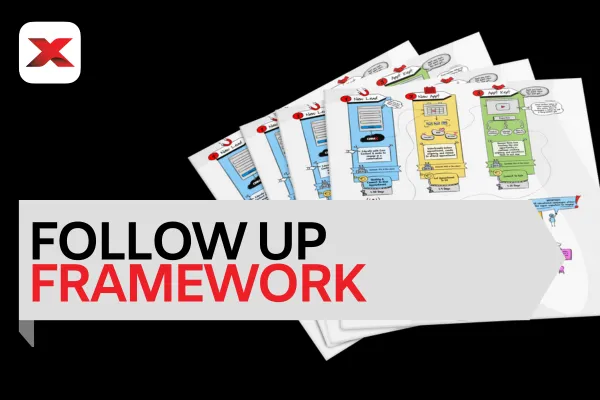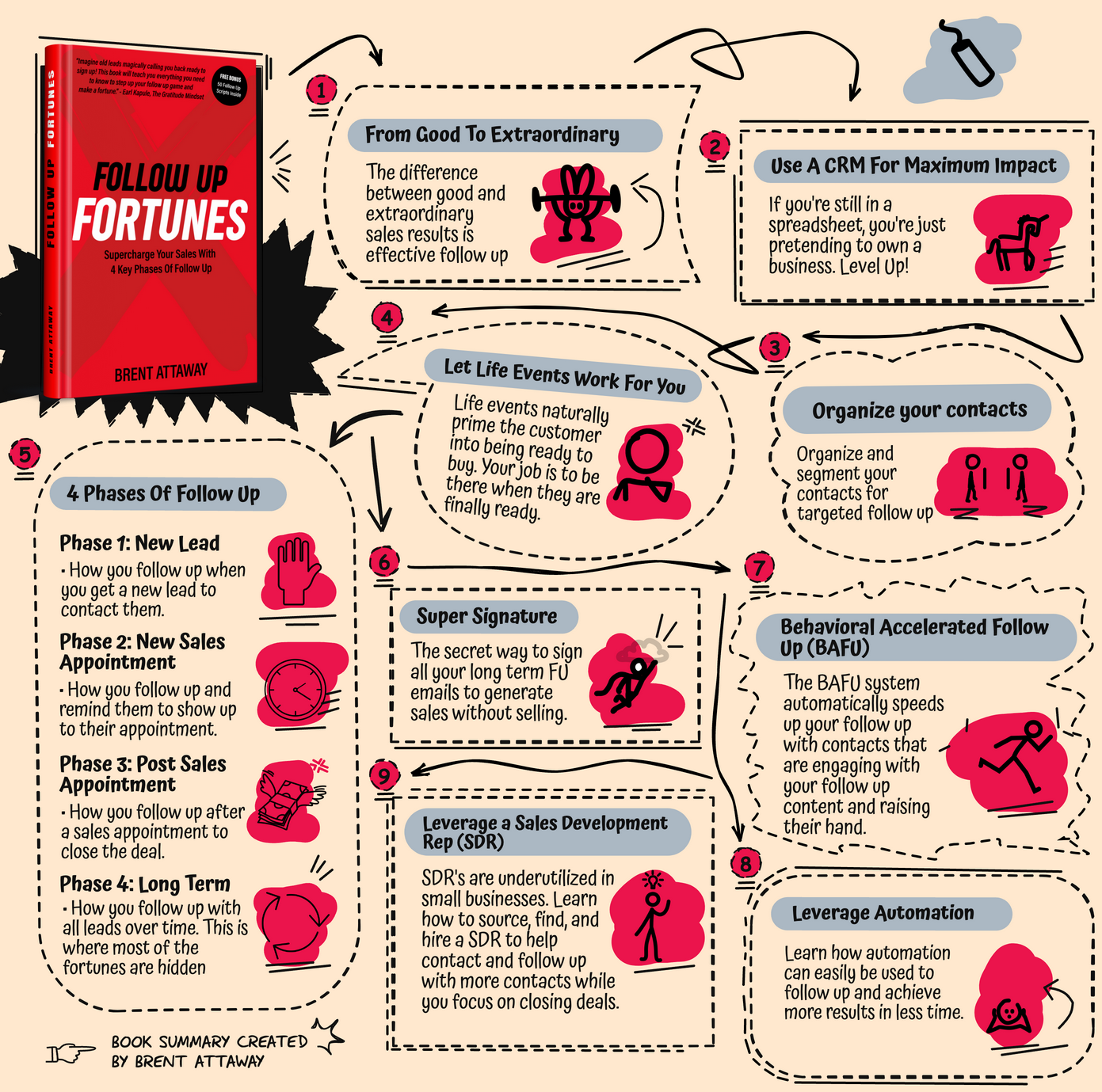CRMX Blog

Mastering Follow-Up: The 4 Phase Framework for Boosting Sales
Mastering the 4 Phase Follow-Up Framework: Boost Your Sales and Conversions
“When you simplify follow-up efforts, suddenly it doesn’t sound so overwhelming, and soon you will see the fortunes start pouring in.”
– Brent Attaway
Introduction
In the fast-paced world of sales, follow-up is king. It’s the difference between closing deals and missing out on potential revenue. To make follow-up simple and effective, I created the 4 Phase Follow-Up Framework. This framework is designed to help anyone, from beginners to seasoned pros, understand and execute both basic and advanced follow-up practices. Let’s dive into the four phases:
1. Phase 1: New Lead
2. Phase 2: New Sales Appointment
3. Phase 3: Post Sales Appointment
4. Phase 4: Long Term Follow-Up
By focusing on these phases, you can systematically convert more leads into sales. The best part? You don’t have to tackle all four phases at once. Start with one, master it, and then move on to the next. Let’s break down each phase in detail to maximize your sales potential.

Phase 1: New Lead
Goal: Qualify and convert to a sales appointment.
Strategy: Educate with core content and invite to engage in a conversation.
Timeline: 1-30 days.
Defining a Lead
A lead is a contact who has expressed interest in your product or service and provided some type of contact information (phone number, email, social media connection, or mailing address).
Many sales professionals misunderstand the distinction between marketing and sales. Marketing is about generating leads and preparing them for a sales appointment. Selling is about presenting your product or service to a prospect, asking them to sign the contract, and delivering payment.
Immediate Actions
The First 72 Hours:
1. Day 1: Send a text, email, and call.
2. Day 2: Send a text, email, and call if no response.
3. Day 3: Send a text, email, and call if no response.
Example Messages
Online Leads:
• Text: “Hi [Name], it’s Brent with [Company]. I just saw your [action] and it looks like your home is qualified. I’m happy to get a free [offer] for you. Would you like me to get that going for you?”
• Email: Similar to the text, but with more detail and a formal tone.
• Phone Call: Use the same message as the text. If you get them on the phone, qualify them and set the appointment.
Door-to-Door Leads:
• Text: “Hi [Name], it’s Brent with [Company]. It was a pleasure meeting you today. I’m happy to get a free [offer] for your home. I’m free to drop by tomorrow between [time], does that work for you?”
• Email: Similar to the text.
• Phone Call: Use the same message as the text.
Day 4-30 Follow-Up
After the first 72 hours, adjust the pace and tone of your follow-up. Continue reminding the prospect of their interest and start educating them with your core content. Use emails to address one topic per email and include a call to action to schedule a call. Each phone call should aim to qualify and set an appointment.
By focusing on this phase, you can increase your sales appointments by 2-3%, which can significantly impact your annual income.
Phase 2: New Sales Appointment
Goal: Get the prospect to attend the appointment.
Strategy: Indoctrinate prospects before they show up, create urgency, and remind them to attend.
Timeline: 1-4 days.
Indoctrinate & Remind
Once an appointment is booked, keep the prospect informed and excited about it. Use indoctrination videos to educate and build trust before the meeting.
Handling Cancellations and No-Shows
Canceled Appointments: Have an automated follow-up sequence to reschedule the appointment, including calls and texts.
No-Shows: Don’t assume they ghosted you on purpose. Check in with them, preferably using a meme or a friendly reminder.
Example Follow-Up Sequence
• Text: “Hi [Name], I’m glad we had a productive meeting today. I’m looking forward to our appointment tomorrow at [time]. See you then!”
• Email: Send a summary of the meeting and any additional information that addresses their concerns.
By implementing this phase, you can increase your show-up rates and reduce the number of canceled or missed appointments.
Phase 3: Post Sales Appointment
Goal: Convert the prospect to a closed deal.
Strategy: Remind the prospect of the benefits, create urgency, and incentivize them to act now.
Timeline: 1-21 days.
Following Up After the Initial Appointment
Start the follow-up process at the end of your initial appointment by gaining a mutual commitment for the next step. Address their objections and set a date for the next action.
Example Follow-Up Sequence
• Text: “Hi [Name], I’m glad we had a productive meeting today. I’d like to schedule a follow-up call to address your concerns regarding [topic]. What works best for you tomorrow… [time] or [time]?”
• Email: Send a link to a personal video message thanking them for their time and addressing any lingering questions.
• Phone Call: If they haven’t replied, call them to book a follow-up appointment.
By focusing on this phase, you can increase your chances of closing the deal by handling objections effectively and keeping the conversation moving forward.
Phase 4: Long-Term Follow-Up
Goal: Educate, entertain, engage, and schedule sales appointments.
Strategy: Use a combination of educational series, promotions, and engagement campaigns.
Timeline: Forever.
Building Know, Like, and Trust
Long-term follow-up is essential for building relationships with your prospects. Consistently deliver value through educational content, entertaining messages, and engaging campaigns.
Example Long-Term Follow-Up Tactics
• Emails: Regular newsletters with valuable information and promotions.
• Social Media: Consistent posting and interaction to keep your brand top of mind.
• Special Offers: Periodic promotions to incentivize action.
By maintaining long-term follow-up, you ensure that your prospects continue to know, like, and trust you, increasing the likelihood of future sales.
Conclusion
The 4 Phase Follow-Up Framework is your blueprint for turning leads into sales. By mastering each phase, you’ll see an increase in sales appointments and conversions, leading to higher revenue and business growth. Remember, start with one phase, master it, and then move on to the next. Consistent follow-up is the key to building relationships and closing deals. Now, go out there and make those fortunes pour in!

